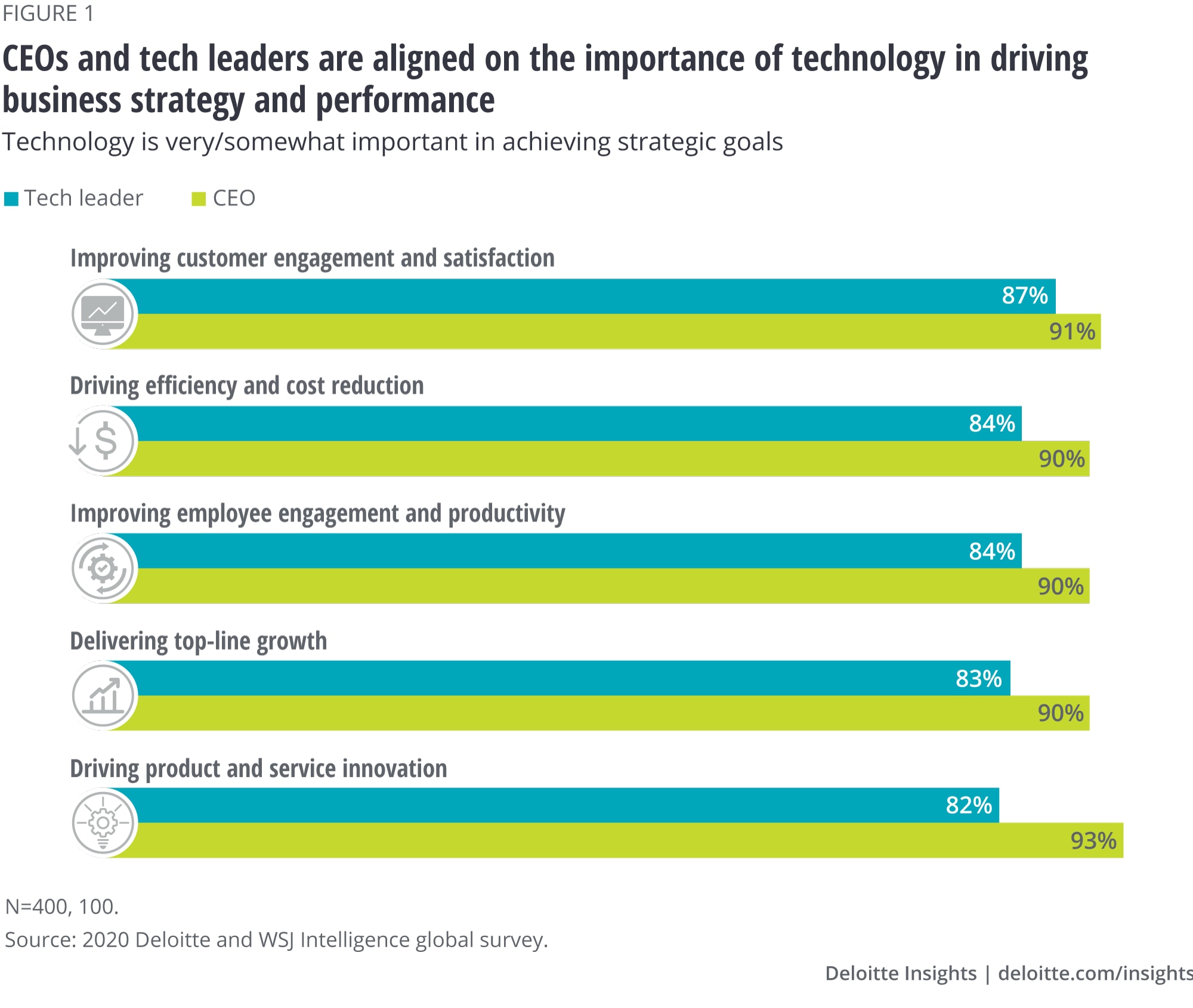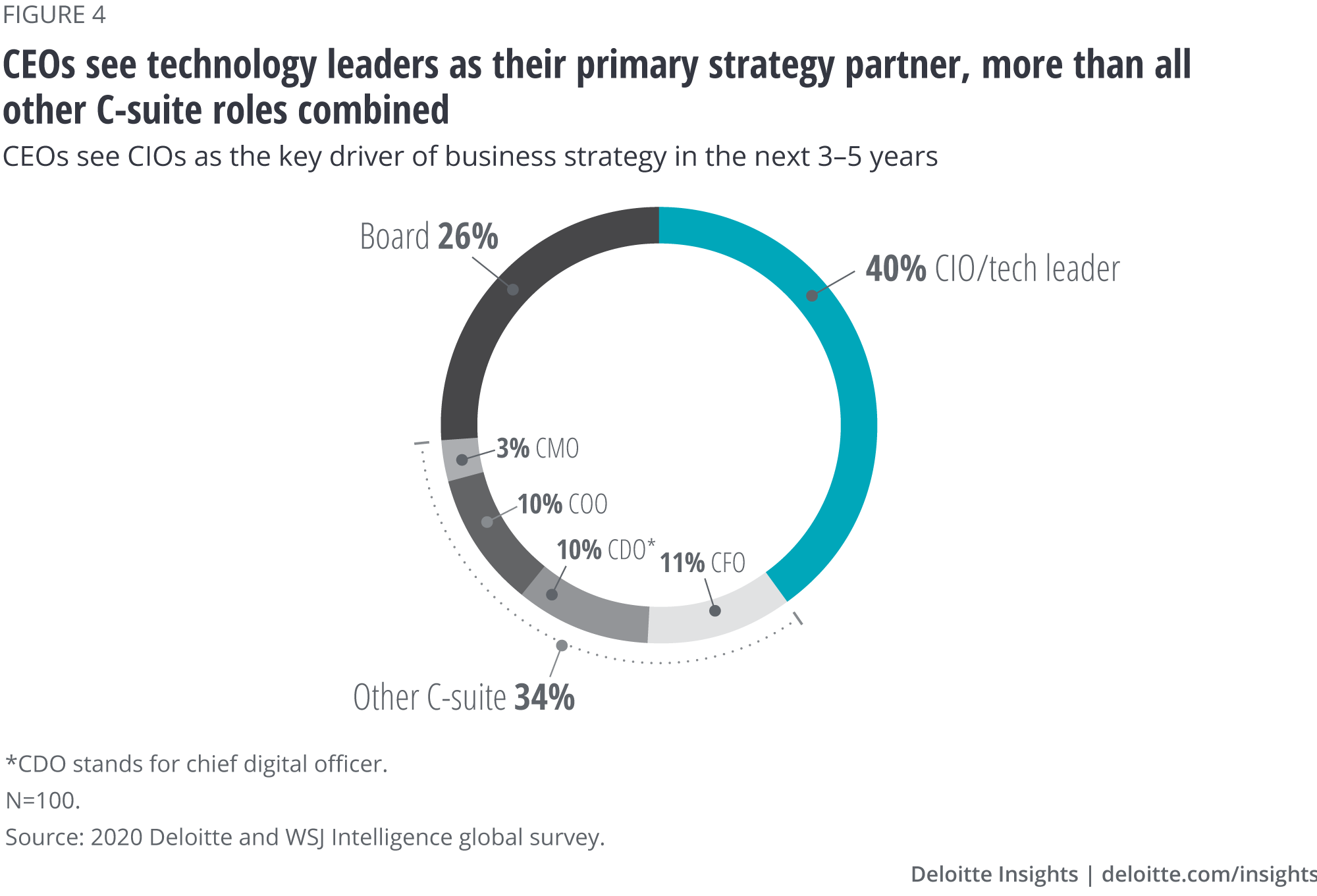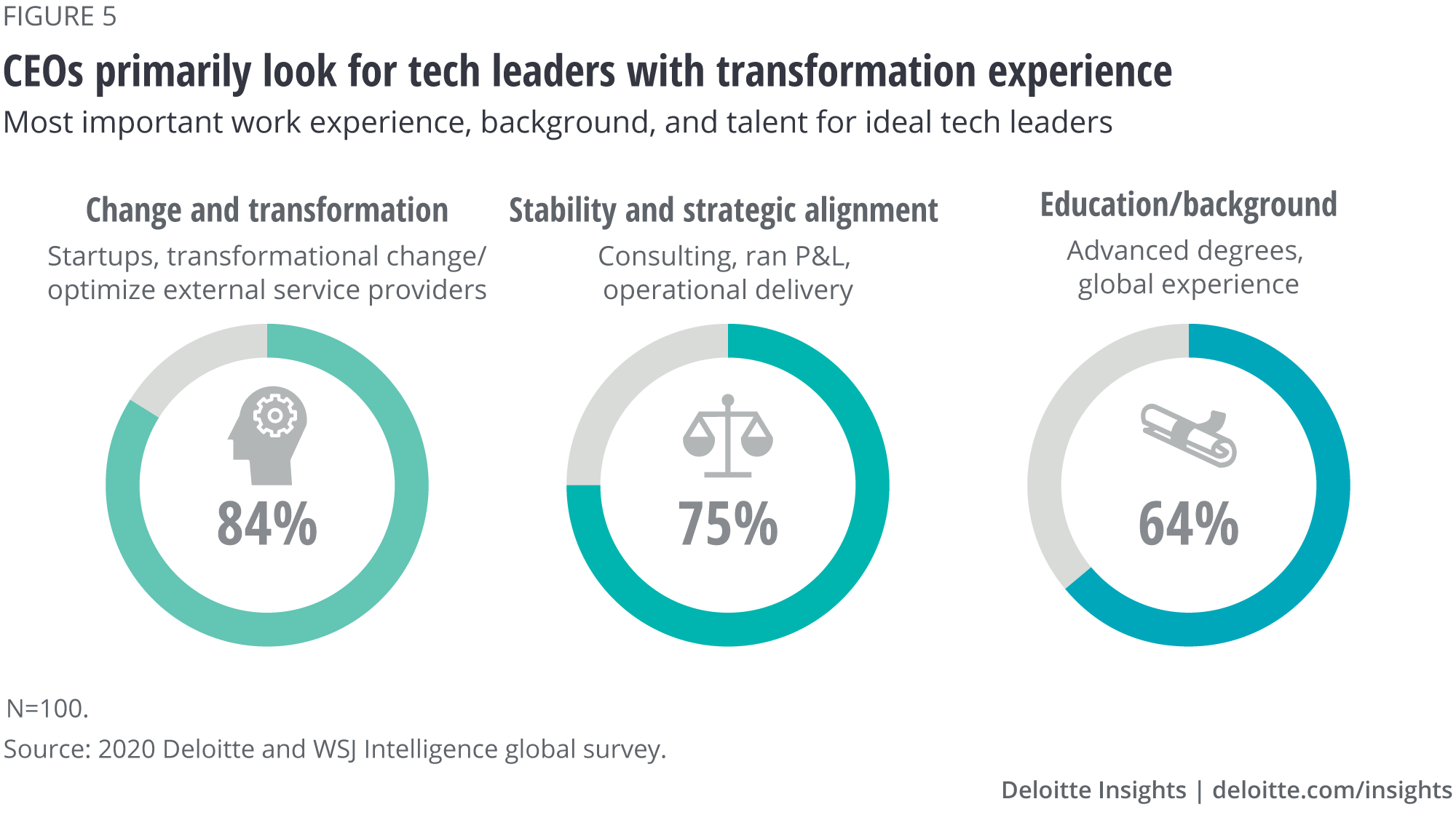
The new CIO: Business-savvy technologist IT’s role in the organization is changing rapidly—and CEOs are embracing the change
8 minute read
10 April 2020
CEOs not only trust technology leaders to be a strategic business partner and to drive organizational change through technology—they are clamoring for tech executives to do so. The opportunities for forward-looking tech executives are vast, as are the perils for those who don’t answer the call to be agents of transformation.
Introduction
While technology and digital transformation are widely seen as critical to the success of virtually every business, in the past, CEOs and tech leaders haven’t always seen eye to eye on strategy and tactics. This research is the first part of a multidimensional study exploring the changing role of the tech leader, expectations of CEOs, and how the technology function should evolve to respond to these changes.
Learn more
Read the 2020 Global Tech Leadership Study
Read more from the CIO Insider collection
Learn about Deloitte’s services
Go straight to smart. Get the Deloitte Insights app
To explore these shifts, Deloitte and WSJ Intelligence teamed up to engage with 100 CEOs and 400 tech leaders across 22 industries and 19 countries. Our goal was not just to discover CIOs’ and CEOs’ perspectives about digital transformation and business strategy in isolation; we also wanted to delineate the relationship of these two C-suite roles and find out where they agree, where they are in conflict, and how equipped they are to work together to enable their companies to succeed.
To identify leaders of the pack, we asked respondents to rate their organization across seven measures of success: profitability, revenue growth, stock performance, digital maturity, innovation, customer engagement, and employee engagement/productivity. Companies that are leading-class or had above-average performance in all seven areas were categorized as “high performers.” Respondents whose companies fell short on one or more of the metrics were labeled “mainstream.”
Technology drives business strategy
Success in business today, across several dimensions, is highly correlated to technology competence. Our research shows the attitudes of CEOs and tech leaders are remarkably in sync about the importance of technology to enable business strategy; in fact, CEOs even say technology is slightly more important than their CIO counterparts (figure 1).

This is great news for tech leaders who are shaping their technology functions to deliver significantly more value to their organizations. They have air cover from the highest levels of their companies to do so. This more integrated, strategic approach to technology can have ramifications across the organization. Digital cannot be a standalone initiative but should be embedded in the business strategy. CEOs are signaling that the technology function cannot operate as a siloed entity, struggling to get funding and support, and make a meaningful impact on the business. The invitation to tech leaders is clear: They have a critical role in developing and fostering business strategy, and their readiness to leverage technology is a key competence. The challenge is also very clear: If they don’t step up, other leaders within the organization will likely take on these roles.
“The role of a technology leader is not to develop a digital strategy or vision—it is to embed digital in the business strategy,” says Larry Quinlan, global CIO of Deloitte.
Our research shows high performers are 2.5 times more likely to make technology a top focus to advance organizational goals, and their IT functions are almost 3 times more likely to be viewed as ready and responsive to leverage the emerging technologies (figure 2).

High performers are also nearly twice as likely to call technology very important across all measured strategic goals, from improving employee and customer engagement to driving product innovation to delivering top-line growth as well as driving efficiency and cost reduction. Interestingly, CEOs across all companies agree technology is essential to achieve these business goals.
“The role of a technology leader is not to develop a digital strategy or vision—it is to embed digital in the business strategy.”—Larry Quinlan, global CIO of Deloitte
For tech leaders, this should be a starter’s gun. The trick is to help ensure the exploration of emerging technologies is not divorced from real business is- sues. This is an opportunity to show business and technology acumen and help co-create solutions that optimize existing business and deliver future growth. They can have the confidence that this is precisely what CEOs want from them.
Shifting focus to business innovation may not be easy for many tech leaders. The primary obstacles in leveraging technology to drive business value and impact are legacy environments, insufficient talent, and lack of business leadership and prioritization processes (figure 3).

To overcome these challenges, tech leaders should shift the mindset of the tech function from operator to creator.
“We created an internal brand statement for our technology professionals: ‘influential leaders in business’ with a strong understanding of business and the know-how to leverage data, people, process, and technology. These are leaders who are able to innovate in business, and they happen to bring digital skills to the table,” says Nicholas Fourie, VP of ICT at Fisher & Paykel Healthcare, a global healthcare organization specializing in respiratory care.
The question, then, is how exactly can tech leaders become a transformational force? As the technology landscape changes around them, how can they change or at least fortify their current skills? Here, too, our survey provided guidance on how CEOs and CIOs at high-performing companies plan to create difference-making IT operations that are catalysts for change in their organizations.
The future tech leader
Clear evidence of the importance of the CEO/tech leader relationship: CEOs now see CIOs and tech leaders as their primary partners in driving business strategy. Forty percent of CEOs said their tech leader will be the key driver of business strategy. This percentage is more than those who named their CFO, CDO, COO, or CMO as their top partner in business strategy combined (figure 4). This remarkable level of confidence by CEOs also brings a significant obligation for tech leaders.

Meeting CEO expectations for this partnership requires a new kind of leadership that goes beyond the conventional view that IT’s role is primarily to drive efficiency and ensure system stability. While deeply ingrained in many organizations, this outlook often does not best serve today’s business and CEO needs. Both CEOs and CIOs believe the CIO should go beyond merely aligning with the business and become the driver of change.
“CIOs have to help the company think about what’s coming and be knowledgeable about what’s happening in the tech world. They’re the ones who have to help educate the rest of the leaders,” says Theresa Drew, board member of Cato Corporation and Sonoco Products. “The CIO’s job is to bring the organization forward to be innovative and forward-thinking.”
As CEOs become increasingly dependent on their CIOs to shape and execute business strategy, they want those CIOs to have deep business acumen and experience as well as the ability to deploy emerging technology. In exploring what CEOs desire in terms of prior experience for their tech leaders, a clear picture emerged, centered on the tech leaders’ demonstrated ability to drive change and transformation (figure 5).

Technology proficiency is still critical, of course, but tech expertise and skills are now table stakes. Over the next three to five years, both CEOs and tech leaders agree tech organizations will also need to instigate and co-create business value in conjunction with other functions. Technology will play a pivotal role in delivering this change. “IT expects to be part of the business, not just an order taker,” says Marcos Rosalen, CIO of Ultragaz, a major Brazilian energy company.
CEOs are looking for leaders who can shepherd their organizations through these times of change. Experience with change and transformation projects are the most desired backgrounds (experience at a startup, venture capital, or private equity firm; leveraging external services providers to drive innovation; and successfully delivering a large transformation project). Less important, although still valuable, are backgrounds fostering operational stability and strategic alignment, such as experience at a consultancy or a record of running a P&L. Education and background, including global responsibility and advanced educational degrees in engineering/science or business, might be valued as baseline requirements for the role but do not appear to provide a competitive edge for the tech leader of tomorrow.
In recent years, there has been a push for tech leaders to develop stronger relationships with their C-suite colleagues. While that is certainly important, the characteristics of those relation- ships should be different than in the past, as well. Going forward, CIOs will likely increasingly need to be influencers, capable of bringing people together and moving them forward.
Business strategy, rather than digital strategy, will be the nexus for how CIOs interact with other business leaders. Technology will be a byproduct rather than the focus of their conversations. Successful tech leaders will likely focus on developing tech talent with emotional intelligence, empathy, and active listening more than just proficiency in artificial intelligence, analytics, and the Internet of Things.
“Tech leaders need an informed opinion, and that comes from really understanding the business. Having a dialogue with business leaders is table stakes, but it’s also about uncovering perspectives through research,” says Samir Daiya, CIO of Motorola Solutions, a US data communications and telecommunications equipment provider. “It’s essential to intrinsically understand the business to increase speed and precision versus being robotic about business cases all the time and corresponding priorities.”
Changing or fortifying the culture will likely not happen in one fell swoop but in thousands of small steps and day-to-day decisions that will transform the IT function. Going forward, tech teams will need personnel skilled in collaboration, transformation, and working with the business to create value—nontraditional IT skill sets. Operational and tactical expertise will likely increasingly be outsourced, liberating valued staff for higher-level work.
“Tech leaders need an informed opinion, and that comes from really understanding the business. Having a dialogue with business leaders is table stakes, but it’s also about uncovering perspectives through research.”— Samir Daiya, CIO of Motorola Solutions
Conclusion
The yin and yang of technology leadership
Tech leaders will have to balance their role of a strategic business partner with the responsibility of being the evangelist for technology-enabled change across the organization. CEOs not only trust them to be this force, but they are also clamoring for them to do so. CEOs are aligned with tech leaders about the necessity of driving change through technology. CIOs have the license to push the boundaries, knowing that the CEO has their back.
“We are both driving and enabling; we call it yin and yang,” says Anne Nørklit Lønborg, CIO of Tryg, a Scandinavian insurance company. “The business is pulling us forward, but we’re also starting to push technology opportunities to the business in order to influence the business and its strategy. We’re trying to improve the IT organization to be proactive and positioned as a business unit instead of being a reactive staff function and pulled by the organization, but it’s a constant back and forth.”
Tech leaders don’t just have a seat at the proverbial table, but CEOs are pulling the chair out and inviting, if not expecting, them to sit down and deliver. The opportunities for forward-looking tech executives are vast, as are the perils for those who don’t embrace the new competitive realities and answer the call to be agents of transformation.
CIOs who go beyond what their CEOs are asking of them can be valuable partners. Those who don’t could see themselves marginalized and overtaken by chief digital officers and others who are ready to accept a transformational role. A conversation needs to happen and will happen—and it’s up to the CIO to drive that conversation.
Appendix
About the research
This research was conducted from November 2019 to January 2020, across 19 countries, with an aim to better understand the necessary talents, expertise, and background of the CIO role. The research was conducted through in-depth interviews and online surveys. Globally, 400 technology leaders and 100 CEOs participated in the quantitative research across 22 industries. We collected the data at the detailed industry and sector level and aggregated it back to six major industry categories for easier analysis. “High performers” were defined as respondents that answered “leader” or “above average” [top 2 responses out of 5 ratings] in all seven measured performance metrics.

The Wall Street Journal news organization was not involved in the creation of this content.
© 2021. See Terms of Use for more information.
Explore more Leadership content
-
The heart of resilient leadership: Responding to COVID-19 Article5 years ago
-
The CIO's innovation agenda Summary
-
The CEO as ultimate end-user ethnographer Article5 years ago
-
Lessons in ambidextrous leadership Article5 years ago
-
Stepping up: The CIO as digital leader Article7 years ago














